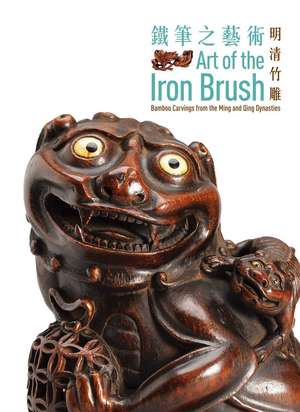Art of the Iron Brush: Bamboo Carvings from the Ming and Qing Dynasties: Distributed for HKU Museum and Art Gallery
Text de Ben Chiesa, Paul Pui Keung Yuen Limba Engleză Paperback – 17 apr 2019
Durable, flexible and abundant in nature, bamboo has been used as a material and a subject in Chinese art for millennia. Because it bends in a storm but does not break, it was particularly associated with the integrity and personal virtue of the scholarly elite, who embraced its symbolic value by planting bamboo in their courtyards, observing it in the wild, and by producing, acquiring and displaying delicate bamboo objects suitable for various scholarly pursuits, such as painting and calligraphy. During the Ming dynasty (1368–1644), scholarly and imperial patronage transformed bamboo carving into a major art form. Scholar-carvers and workshops centred around Jiading (in present-day Shanghai) and Jinling (now Nanjing) produced large numbers of brush pots, wrist rests, miniature landscapes, figurines and other objects. Many bamboo carvers also worked in other materials soft enough to be manipulated with the ‘iron brush’—a term for knives and other carving tools used by literati to transfer their brushwork aesthetic to other media—including boxwood, rhinoceros’ horns and ivory, which shared a kind of loose identity under the heading of diaoke (‘carving’ in modern Chinese). Small in scale yet teeming with life, these works reflect prodigious technical skill and great imaginary involvement because of the unique shapes and contortions of the materials involved. ???????,?????,?????????????????????????????,???????,???????????????????????????????????????,???????????????????????????????????,?????????? ??(?????????)????????????????????????????????(???)???(???)???????????????????????????????????????????????????????????-- ??????????????????????????????-- ????????????????????????????????????????????????????????????????????,????????????????????
Preț: 186.45 lei
Nou
Puncte Express: 280
Preț estimativ în valută:
35.68€ • 37.35$ • 29.52£
35.68€ • 37.35$ • 29.52£
Cartea se retipărește
Doresc să fiu notificat când acest titlu va fi disponibil:
Se trimite...
Preluare comenzi: 021 569.72.76
Specificații
ISBN-13: 9789881902566
ISBN-10: 9881902568
Pagini: 116
Ilustrații: 71 color illus.
Dimensiuni: 219 x 298 x 13 mm
Greutate: 0.64 kg
Editura: Hong Kong University Press
Colecția HKU Museum and Art Gallery
Seria Distributed for HKU Museum and Art Gallery
ISBN-10: 9881902568
Pagini: 116
Ilustrații: 71 color illus.
Dimensiuni: 219 x 298 x 13 mm
Greutate: 0.64 kg
Editura: Hong Kong University Press
Colecția HKU Museum and Art Gallery
Seria Distributed for HKU Museum and Art Gallery
Descriere
Durable, flexible and abundant in nature, bamboo has been used as a material and a subject in Chinese art for millennia. Because it bends in a storm but does not break, it was particularly associated with the integrity and personal virtue of the scholarly elite, who embraced its symbolic value by planting bamboo in their courtyards, observing it in the wild, and by producing, acquiring and displaying delicate bamboo objects suitable for various scholarly pursuits, such as painting and calligraphy. During the Ming dynasty (1368–1644), scholarly and imperial patronage transformed bamboo carving into a major art form. Scholar-carvers and workshops centred around Jiading (in present-day Shanghai) and Jinling (now Nanjing) produced large numbers of brush pots, wrist rests, miniature landscapes, figurines and other objects. Many bamboo carvers also worked in other materials soft enough to be manipulated with the ‘iron brush’—a term for knives and other carving tools used by literati to transfer their brushwork aesthetic to other media—including boxwood, rhinoceros’ horns and ivory, which shared a kind of loose identity under the heading of diaoke (‘carving’ in modern Chinese). Small in scale yet teeming with life, these works reflect prodigious technical skill and great imaginary involvement because of the unique shapes and contortions of the materials involved.

